In last week’s post we looked at the life of Jack Kay, the fortune teller of Haworth who inspired the fortune telling scene in Charlotte Brontë’s Jane Eyre. Included in the post was a picture of Timothy Dalton as Rochester in his fortune teller’s guise, and I was asked why that scene is so rarely included in television and film adaptations of this great novel? It’s an excellent question, so that’s something we’re going to look at today, as well as assessing three of the greatest recent Jane Eyre adaptations.
After reading my post last week, Amy Louise Maris commented, ‘It’s always been a source of great disappointment to me that most (all but one?) adaptations in film omit this great scene in Jane Eyre. It is one of my favourites. Interesting post!’ Thanks Amy, and thanks to everyone who comments on my posts, they’re always welcome.
I’ve always found the fortune telling scene to be a very interesting one, and one that serves well to move the plot forward – Rochester is becoming ever more enamoured of Jane, despite the attractions of Blanche Ingram, and this odd ruse is his attempt to discover if his feelings are reciprocated. It shows Rochester in a more playful light than he had hitherto been seen, but it also shows his capacity for self-interest as it is, after all, rather a cruel trick to play.
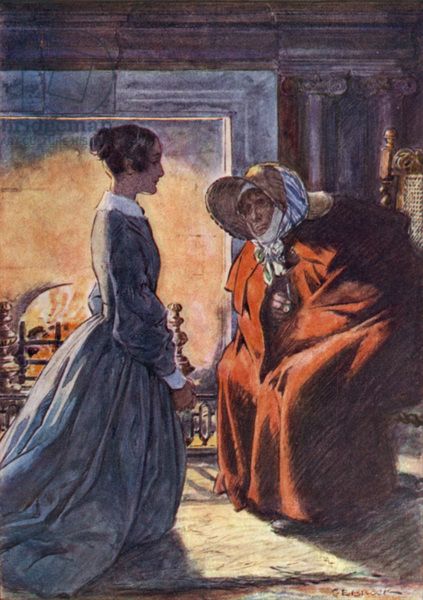
It could well be that Charlotte was influenced by a cynicism when it came to supernatural phenomena and psychic abilities. Whilst society in general is much more open to the possibility of some psychic phenomena, it’s still true that a healthy cynicism remains prevalent and that some people find the possibility of such phenomena to be contrary to their religious beliefs. With that in mind, film and television producers may be tempted to consign this interesting scene to the dustbin.
There is another scene which is often overlooked when it comes to adaptations. In the aftermath of her supposed wedding day to Rochester, the ever proud Jane determines to leave Thornfield Hall, and the man she still loves, forever. She eventually finds herself on the desolate moors of the Peak District, but most adaptations show Jane wandering dejectedly around the moors and then finding herself, hungry and bedraggled, at the home of the Rivers family in Morton (based upon the real life Derbyshire village of Hathersage visited by Charlotte and Ellen Nussey).
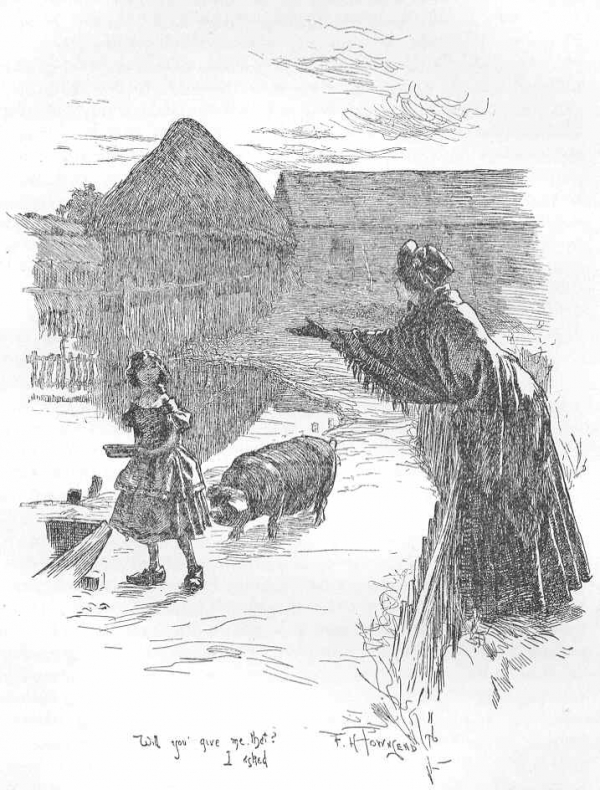
In choosing this route, the adaptations miss a very moving scene in which a starving Jane is forced to beg for scraps of food that were intended for pigs. I believe this scene is important because it shows the physical and emotional nadir that Jane had reached, but it also shows her finally overcoming her pride that until then had been an unconquerable, controlling emotion. I believe that Charlotte is showing us that both Jane and Rochester have to overcome their pride before they can finally find a lasting love together – Jane’s epiphany comes as a result of her sudden poverty and hunger and Rochester’s as a result of his sudden blindness and disability. Charlotte is saying that despite their different social backgrounds, Jane and Rochester are the same emotionally and spiritually, with the same frailties – they are indeed equal, just as they affirm so powerfully in the beautifully and moving proposal scene.
In my opinion, Jane Eyre adaptations would be even better with these two scenes included, but there are still some brilliant adaptations out there. Three of the most modern adaptations have to be among the very best, so let’s take a brief look at them now:
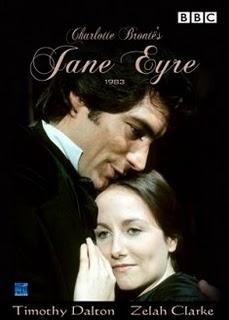
1983: We’ve already encountered the 1983 adaptation by the BBC, and it was one that did show Rochester’s fortune telling farce. Against very fierce competition, this has to be my favourite adaptation and that’s down to three things – the first two being its leads, Zelah Clarke as the eponymous heroine and Timothy Dalton as Edward Rochester. For me, these two will forever epitomise these roles.
Zelah is small, determined and pronounces her words very clearly and deliberately, which I think is perfectly fitting for the determined and proud governess. Her Jane is often reserved, but the strength of Zelah’s portrayal is that you are never in any doubt about her hidden passions and fire within.
Some have commented that Timothy Dalton is just too handsome to play Rochester, as the protagonist is described as plain, even ugly, by Charlotte. These adjectives could clearly never be applied to Timothy, famous now as a James Bond, and yet I find him entirely convincing. This Welsh actor delivers a very convincing northern accent throughout, but once again we can see his inner emotions despite a bluff, uncompromising exterior.
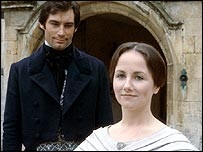
The third positive for me in this adaptation is that it remains incredibly faithful to Charlotte Brontë’s original text, which surely has to be a positive. I think this trilogy of factors reaches its zenith in the proposal scene – Rochester looks troubled and feverish, Jane looks angry at first, but the denouement of this scene is entirely romantic and entirely believable. I’d also like to take a moment to praise the gentle, yearning theme music by Paul Reade, which is entirely in keeping with this loving and loveable adaptation.
2006: The BBC returned to Jane Eyre in 2006 for a four part adaptation which is many people’s favourite version, and which gives the 1983 adaptation above a real run for its money in my opinion. Our protagonists are played this time by Ruth Wilson and Toby Stephens. They handle the roles with aplomb and the only real criticism is the one levelled against Timothy Dalton: namely that they’re just too good looking to play Charlotte’s characters. That we soon forget this, however, is testimony to their acting and the directing by Susanna White.
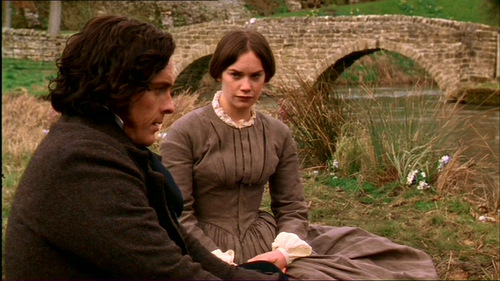
This is a very stylish and lavishly filmed production, with a series of almost cinematic scenes that hold great visual appeal. Even so, it never fails to engage the heart and mind as well as the eyes, and there’s real chemistry between the main characters. Toby already had a fine Brontë pedigree when he stepped into Rochester’s shoes, as he had played Gilbert Markham in the BBC’s 1996 adaptation of The Tenant Of Wildfell Hall. Starring as Helen alongside him on that occasion was the brilliant Tara Fitzgerald who can also be seen here as Jane’s wicked aunt Mrs. Reed.
There are some differences from the original novel, however. Firstly, Rochester doesn’t disguise himself as a fortune teller but hires one, which as Emma has explained above may be a more realistic interpretation of what was happening in country houses at the time. Secondly, Jane’s flight across the moors is condensed, although Ruth Wilson still does an excellent job in portraying Jane’s despair and vulnerability at this time.
All of these adaptations are well worth watching, and there are many other Jane Eyre adaptations to try too, including the recent National Theatre adaptation with the very first version being filmed in 1910. If you have a spare hour or so, why not watch this 1934 film version right here, but be warned that it’s not quite as, er, sophisticated as some later adaptations:
There’s a Jane Eyre for everyone, which is a fitting tribute to the power of Charlotte’s work. Join me next Sunday for another new Brontë blog post. Stay happy and healthy, keep reading the novels and watching the films.
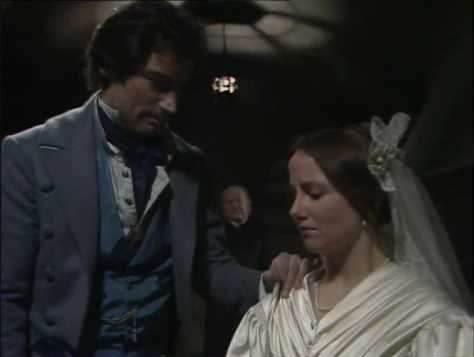
Thank you for all the opinions of the 3 versions of Jane Eyre. I’ve seen the Timothy and Zelah adaptations & like it very much. But I also enjoyed director Robert Young’s version, starring Samantha Morton as Jane and Ciran Hinds as Mr Rochester. I’ve read Bronte’s Jane Eyre but after reading Emma’s excellent insights, I think I’ll re-read it and also watch the other recommended versions. Being an author I sincerely thank you for sharing your excellent knowledge about one of the greatest women writers of all times (of course I’m including Jane Austen as also one of the greatest).
I agree on the first two. I’ve only seen 2011 once — but the 1983 and 2006 are the finest and I’ve watched both at least twice. There are moments in the one in the later 1990s with Ciarhan Hinds and Samantha Morton that are very fine.
FWIW, to me the finest of the Wuthering Heights are a BBC in 1978 (it takes us through the whole novel) and the 1992/3 with Fiennes and Binoche. There are moments in that original 1939 which are unbeatable too.
I do like the Tenant of Wildfell Hall with Rupert, Graves, Toby Stevens (again) and Tara Fitzgerald
Ellen
Thanks so much for your interesting comments on ‘Jane Eyre’ a source of endless interest. You will be interested in my upcoming book ‘The Sexual Politics of Jane Eyre: Fear and the construction of Text in Charlotte Bronte’s Jane Eyre’ which is a new reading of the novel and in which I pay attention to Jane’s sojourn as a beggar (contextualised within Thomas Malthus’s comments) http://www.eerpublishing.com/erskine-sexual-politics-of-jane-eyre.html
I greatly enjoyed your insights into Jane Eyre productions. The 1983 and 2006 versions are my favorites out of the many I’ve seen (and reviewed at JaneEyre.net), though the definitive Jane Eyre has yet to be made. However, I found the 2011 film unconvincing for a variety of reasons, including Fassbender’s subdued performance, though every Judi Dench scene was enthralling.
I agree that including Jane begging would deepen the viewer’s grasp of her desperate straits and the lines she is forced to cross.
It’s interesting to learn why Charlotte may have chosen to include the gypsy scene in the matter she did. That scene strained belief a bit — both in print and in some films (it was a real weakness of Timothy Dalton’s mainly solid performance in 1983). Thanks for adding to my knowledge of that period!
Thank you Nick and Emma. Lovely post.
Do you know of any modern adaptations of ‘Shirley’ – it does have some bits we might now find unacceptable but very intriguing also. Is an adaptation overdue? There is, of course the silent film of 1922 but this has been lost forever unless one of your readers may know where it might be found.
I am very surprised no mention was made of the 1943 film adaptation of JANE EYRE starring Orson Welles, Joan Fontaine, the wonderful child actress MARGARET O’BRIEN, and, in an uncredited role, ELIZABETH TAYLOR as Helen Burns. The screenplay was written by the great 19th century writer, ALDOUS HUXLEY and the film was directed by ROBERT STEVENSON, best known for directing MARY POPPINS, 20 years later. In my opinion, Welles as Rochester, never had an equal. He captured Charlotte Bronte’s ill-fated, anticlimactic hero as brilliantly as Academy Award winner Joan Fontaine’s sensitive depiction of Jane as she grows from a shy, uncertain creature to a strong, independent woman. This transition is central to the writings of each of the Bronte sisters, whose shared vision, and single most important contribution to literature, and the world, was acknowledging and celebrating the Independent Woman. No other Jane portrayed by the actresses in any of the several subsequent film adaptations seemed to have understood this. The character of Jane is a survivor by necessity, but becomes a woman of courage as she comes to realize that a purposeful and honest life does not come from what others expect of you, but rather, from what you expect of yourself.
Thank you for the insightful post! Even though all adaptations are interesting to watch, my favorite Jane Eyre adaptation is also the 1983 BBC TV series starring Zelah Clarke and Timothy Dalton. Their performances were incredible to watch! The 2011 Jane Eyre had an aesthetic vibe to it and I enjoyed watching Mia Wasikowska’s stellar performance as Jane Eyre. But for me, Michael Fassbendert wasn’t convincing as Mr. Rochester compared to Timothy Dalton. The only scene of Mr. Rochester that really moved me in the 2011 version was when he begged Jane not to leave him. Until then, his acting was a bit dry – a bit monotonous.
I have to say the 2006 version is my favorite followed by the Orsen Welles/Joan Fontaine film. I was completely captivated by both Ruth Wilson and Toby Stephens. They really brought the story to life for me in way that has haunted me days after viewing it.
I’ll have to rewatch these all now. I had a hard time choosing a favorite. I loved the 1997 one till the end, iirc.
Thank you for a well-done analysis of these Jane Eyre adaptations. My introduction to Jane Eyre began with the 1997 version starring Samantha Morton and Ciaran Hinds. While not my favorite version, it will always have a place in my heart.
As for the three you mentioned in this post, the 1983 and 2006 versions remain among my top favorite adaptations of Jane Eyre. Interestingly, I watched the 2006 version around the same time I discovered the 1983 version online years ago. I honestly had no clue that Timothy Dalton had been Rochester or that there was a 1983 version. Both versions are great and well done. 1983 really captures a lot of nearly everything in the novel and I especially like that it added Rochester as a gypsy and Jane’s desperation to eat the scraps of food. It’s a shame the latter is not shown enough in the adaptations, and I like how the 2006 version had Rochester hire the gypsy rather than playing one. The leads in each version also have excellent chemistry.
Personally, I believe miniseries are best for classic novels like Jane Eyre and Austen works, but I like being able to watch what film adaptations can do. Unfortunately, I was not a fan of the 2011 version but after a little more than 10 years since my first watch I decided to give it another go. I liked it better this time around with some good acting and direction, the unique storytelling with Jane’s struggles on the Moors and meeting the Rivers family in the beginning and then proceeding to tell things in a flashback. The cinematography, lighting, and music are good as well to help capture the dark, moody atmosphere that is very present in the book. However, I did not feel Mia and Michael had good chemistry though I wonder if it might be because of how the direction was done.
Outside of the 1910 silent film and some international versions, I feel I have seen most of the Jane Eyre adaptations including the early TV film/playhouse versions. 1934 is my least favorite for obvious reasons but it was produced at the low-budget Monogram Pictures, as such not surprising that it is what it is, however devoted Jane Eyre fans should give a look at least once. 1943 was an improved attempt and worked better at the high budget 20th Century Fox, and Welles was a surprisingly good Rochester. 1949, 1956, 1957, and 1961 are interesting versions of the novel.
Others that are not my favorite but worth a look are the 1973 miniseries which takes most of its dialogue for the original novel. The 1970 film version was lacking for me but marked the first on screen adaptation to include Jane’s time with the Rivers family. Then there is the 1996 version as one of my least favorites.